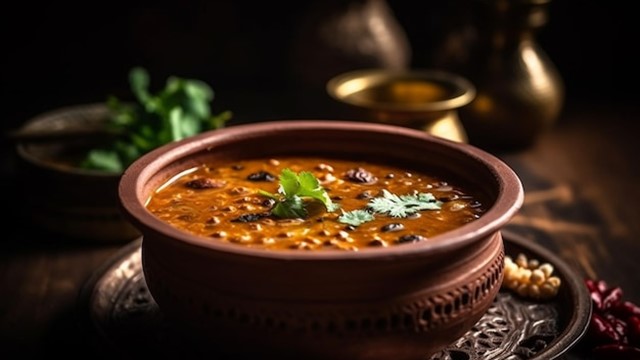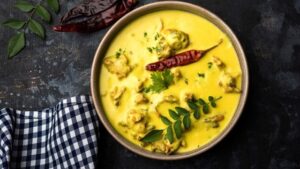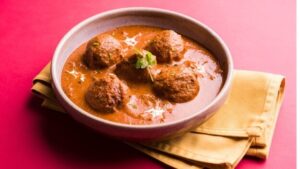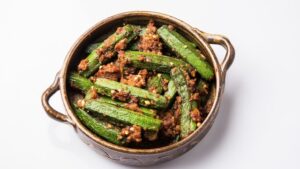Introduction:
Start by introducing Dal Makhani as an iconic Indian dish renowned for its rich, creamy texture and indulgent flavors. Highlight its cultural importance in Indian cuisine and its popularity both nationally and internationally.Dal Makhani, also spelled as Dal Makhni or Daal Makhani, is a classic and popular dish from Indian cuisine, specifically originating from the Punjab region in North India. This dish is renowned for its rich, creamy texture and enticing flavors derived from a slow-cooking process and a harmonious blend of spices.
Histirical background
The historical background of Dal Makhani is rooted in the rustic kitchens of the Punjab region, where this iconic dish originated. Initially known as “Maa ki Daal” or “Kaali Daal,” it was a simple, nutritious meal made by farmers using locally available ingredients. The transformation of this humble fare into the celebrated Dal Makhani is a tale of evolution and refinement.
Centuries ago, the traditional preparation involved slow-cooking black lentils (urad dal) and red kidney beans (rajma) over an open flame for hours, infusing them with smoky flavors. This slow-cooking process not only softened the lentils but also amalgamated the spices and ingredients, enhancing the depth of flavors.
The dish gained prominence in the mid-20th century when it made its way from the rural households to urban restaurants. It was in the bylanes of Delhi’s eateries that Dal Makhani received its modern avatar. The addition of butter (“makhani”) and cream to the simmering lentils elevated its taste, giving birth to the sumptuous and creamy Dal Makhani that we savor today.
Over time, Dal Makhani transcended regional boundaries and became a staple in Indian restaurants worldwide, earning its place on menus and captivating taste buds globally. Its popularity soared not just due to its rich flavors but also because it symbolized the heartiness of Punjabi cuisine, embodying warmth, comfort, and generosity.
This dish’s evolution from a humble, nourishing meal to a globally adored delicacy mirrors the cultural transition of Indian cuisine. Dal Makhani’s journey reflects how a simple recipe from the heartland of Punjab has become an integral part of India’s culinary heritage, cherished by generations and continuing to tantalize palates across the globe.
Cultural significance
The cultural significance of Dal Makhani in Indian cuisine is deeply rooted in history, tradition, and regional heritage. Here are some aspects to consider when discussing its cultural importance:
Regional Heritage:
- Punjab’s Culinary Gem: Originating from the state of Punjab in Northern India, Dal Makhani reflects the rich agricultural heritage of the region. It’s an integral part of Punjabi cuisine, celebrated for its robust flavors and heartiness.
Festive and Celebratory Occasions:
- Festival Fare: Dal Makhani often graces the tables during celebratory occasions, including weddings, festivals like Diwali or Baisakhi, and family gatherings.
- Symbol of Togetherness: Its preparation often involves slow cooking, making it perfect for bringing families together while sharing stories and bonding over a simmering pot.
Social and Cultural Gathering:
- Community Meals: In many Indian households and communities, sharing a meal centered around Dal Makhani signifies warmth, hospitality, and a sense of togetherness.
- Cultural Exchange: Sharing recipes and cooking techniques for Dal Makhani is a way to pass down traditions and preserve cultural heritage.
Culinary Traditions and Techniques:
- Traditional Cooking Methods: The slow-cooking process of Dal Makhani, often in a large pot over a low flame, highlights traditional culinary techniques passed down through generations.
- Respect for Ingredients: The dish’s preparation showcases respect for staple ingredients like lentils, spices, and dairy, reflecting the reverence for nature’s bounty in Indian culture.
Significance in Vegetarian Cuisine:
- Vegetarian Delicacy: Dal Makhani holds a prominent place in Indian vegetarian cuisine, symbolizing the richness and variety of meatless dishes.
- Cultural Acceptance: Its popularity transcends vegetarianism, being cherished by people with varied dietary preferences for its taste and nourishment.
Symbol of Unity in Diversity:
- National Integration: India’s diverse cultures, languages, and traditions find a culinary connection through dishes like Dal Makhani, appreciated across the country regardless of regional differences.
- Cultural Fusion: The dish’s popularity globally signifies the fusion of cultures and the acceptance of Indian cuisine worldwide.
Health benefit
Dal Makhani, a classic Indian dish made primarily from black lentils (urad dal), kidney beans (rajma), spices, and cream, offers several potential health benefits:
Nutritional Value:
- Protein-rich: Lentils and kidney beans are excellent sources of plant-based protein, essential for muscle repair, growth, and overall body function.
- High in Fiber: The dish contains dietary fiber that aids in digestion, promotes gut health, and helps regulate blood sugar levels.
Essential Nutrients:
- Iron: Lentils and kidney beans are rich in iron, vital for producing red blood cells and preventing anemia.
- Folate: A crucial nutrient, especially for pregnant women, aiding in the development of the fetus and preventing birth defects.
Heart Health:
- Low in Saturated Fat: Properly prepared, Dal Makhani can be made with minimal saturated fats, promoting heart health.
- Healthy Fats: When prepared with moderation in cream or ghee (clarified butter), it can offer healthy fats essential for the body.
Weight Management:
- Satiety: High fiber and protein content help you feel fuller for longer, potentially aiding in weight management by reducing overall food intake.
- Controlled Blood Sugar: The dish’s low glycemic index can contribute to better blood sugar control.
Antioxidants and Anti-inflammatory Properties:
- Spices: Many spices used in Dal Makhani, such as turmeric, cumin, and coriander, contain antioxidants and anti-inflammatory properties, potentially benefiting overall health.
Precautions:
- Portion Control: Due to the inclusion of cream and ghee in some recipes, moderation is essential to avoid excessive intake of saturated fats and calories.
- Salt Content: Be mindful of salt added during cooking, especially for individuals monitoring their sodium intake.
Healthy Cooking Tips:
- Using Minimal Fats: Opt for healthier cooking methods like using minimal cream or ghee, or substituting with healthier alternatives.
- Incorporating Vegetables: Adding vegetables like tomatoes, spinach, or fenugreek leaves can enhance the nutritional profile without compromising taste.
Ingredients:
For Cooking Lentils:
- 1 cup whole black lentils (urad dal)
- 1/4 cup kidney beans (rajma)
- Water for soaking and cooking
- Salt to taste
For the Gravy:
- 2 tablespoons ghee or oil
- 1 tablespoon cumin seeds
- 1 large onion, finely chopped
- 2-3 cloves garlic, minced
- 1-inch piece ginger, grated or finely chopped
- 2-3 green chilies, finely chopped (adjust to taste)
- 2-3 medium-sized tomatoes, finely chopped or pureed
- 1 teaspoon red chili powder (adjust to taste)
- 1/2 teaspoon turmeric powder
- 1 tablespoon coriander powder
- 1 teaspoon garam masala
- Salt to taste
- 1/2 cup cream or cashew cream (optional for a vegan version)
- Fresh coriander leaves for garnish
Preparation:
Cooking Lentils:
- Soaking: Wash and soak the black lentils and kidney beans separately in enough water for at least 6-8 hours or overnight.
- Cooking: Drain the soaked lentils and kidney beans. In a pressure cooker, add them with fresh water (about 4-5 cups), salt, and pressure cook until they are soft and well cooked. This usually takes around 20-25 minutes. Alternatively, you can cook them in a pot until soft, but it may take longer.
Making the Dal Makhani:
- Tempering: Heat ghee or oil in a pan. Add cumin seeds and let them crackle.
- Sauté Aromatics: Add chopped onions and sauté until golden brown. Then, add minced garlic, grated ginger, and green chilies. Sauté for a couple of minutes until the raw aroma disappears.
- Add Spices: Put in chopped tomatoes or tomato puree. Cook until the tomatoes soften and oil starts to separate. Add red chili powder, turmeric powder, coriander powder, garam masala, and salt. Mix well and cook for a few minutes.
- Combine with Cooked Lentils: Add the cooked lentils and kidney beans to the spice mixture. Mix thoroughly, mashing a bit with the back of the spoon or a masher to thicken the consistency.
- Simmering: Let the Dal Makhani simmer on low heat for 20-30 minutes. Stir occasionally, ensuring it doesn’t stick to the bottom of the pan.
- Finishing Touch: If using cream, add it now and stir well. Adjust salt and spices according to taste.
- Garnish and Serve: Garnish with fresh coriander leaves and serve hot with naan, rice, or any Indian bread.
Additional Tips:
- For a richer flavor, allow the Dal Makhani to sit for a few hours before serving as the flavors develop over time.
- You can adjust the spice levels according to your preference.
- To make it vegan, substitute ghee with oil and cream with cashew cream or coconut milk.
Enjoy preparing and savoring this delicious and comforting Dal Makhani!




